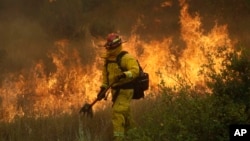Authorities in the western U.S. state of California say a wildfire that began burning more than a week ago has become the largest in the state's history.
The blaze, known as the Mendocino Complex, is made up of two separate fires in the northern part of the state that have merged and collectively burned 115,000 hectares to surpass the December 2017 Thomas Fire in size.
The California Department of Forestry and Fire Protection (CAL FIRE) said as of late Monday the Mendocino fire was only 30 percent contained and was still growing. The flames have so far destroyed about 150 structures.
Doreen Gatewood, a fire information officer working on the Mendocino Complex Fire, told VOA no one had been killed in the blaze. Gatewood said conditions such as high temperatures, low humidity, and heavy wind have persisted in the area, allowing the fire to reach such a massive size.
Nearly 4,000 personnel are working to put out the fire, including crews flying helicopters and planes to drop fire suppressant from above.
CAL FIRE estimated it could bring the fire under control by the middle of next week.
Similar environmental conditions have also contributed to the growth of the Carr Fire, also in the northern part of California. That fire, the 12th largest ever recorded in the state, has proved far deadlier, killing five civilians and two firefighters.
On Sunday, President Donald Trump declared a state of emergency for the area, paving the way for increased federal assistance in fighting the fire.
Trump took to Twitter on Sunday to criticize the state's environmental laws in the wake of the fire.
"California wildfires are being magnified & made so much worse by the bad environmental laws which aren't allowing massive amounts of readily available water to be properly utilized. It is being diverted into the Pacific Ocean. Must also tree clear to stop fire from spreading!" Trump wrote.
LeRoy Westerling, an environmental professor at the University of California, Merced, disputed Trump's comments.
"We do manage all of our rivers in California, and all the water is allocated many times over. So I'm not sure what he was recommending," Westerling told The San Francisco Chronicle.
Allie Weill, a fire behavior researcher at the University of California, Davis, told VOA that in recent years the climate conditions that make such large fires possible have been present earlier and longer in the state.
"This is part of a trend, the new normal, that we've got to deal with," said California Governor Jerry Brown.







